Imagine discovering one of the most mysterious and fascinating churches in Italy: the Temple of Valadier, a neoclassical jewel carved into the rock, set within the karst complex of the Grotta della Beata Vergine, part of the larger Frasassi Caves system, nestled among the green valleys of the Marche. Built in 1828 at the request of Pope Leo XII, a native of Genga, this octagonal sanctuary of white travertine crowned with a lead dome stands beside the ancient Hermitage of Santa Maria infra Saxa, at the heart of a landscape that blends untamed nature, sacred history, and spiritual atmosphere. It is considered a one-of-a-kind place, uniting architecture, spirituality, and landscape in an experience that truly takes your breath away.
In this article, you will discover how to reach it from the main access points, its ancient spiritual roots, the artistic treasures it preserves, and how to combine it with a visit to the Frasassi Caves for an extraordinary itinerary.

Why visit one of the most unique churches in Italy
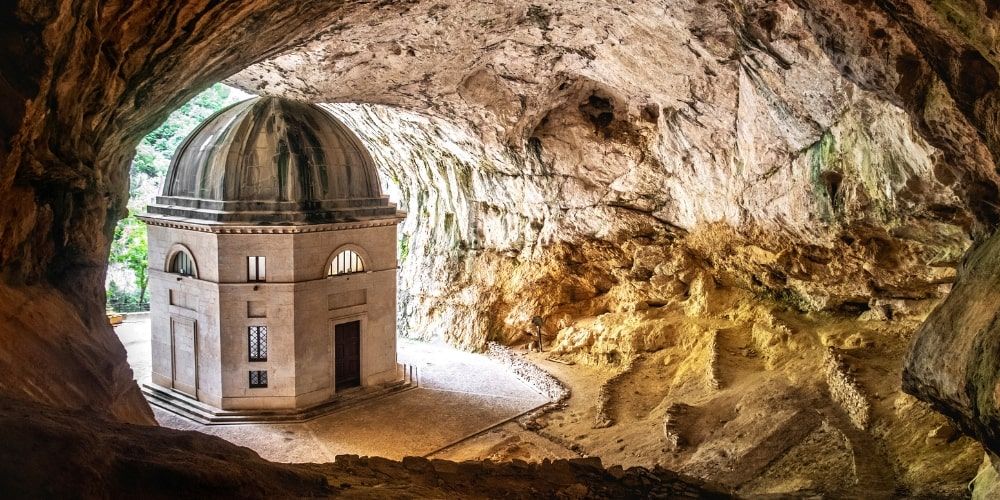
Why should you add the Temple of Valadier to your itinerary? Because here, art, nature, faith, and history don’t simply stand side by side—they merge in an extraordinary way. This is a church unlike any other in Italy: imagine a neoclassical sanctuary nestled within the walls of a cave, embraced by living rock and the lush vegetation of the Gola della Rossa.
Inside, beyond the octagonal design and gleaming blocks of white travertine, you’ll find a statue of the Madonna and Child, a copy from a workshop attributed to Canova, while the original is preserved in the Museum of Genga. Every detail—from the lead-covered dome to the striking interplay of light and shadow—shapes a sensory experience that is both intense and unforgettable.
It’s a chance to uncover something off the beaten path: not the usual tourist stop, but a place that speaks of quiet spirituality, refuge, and contemplation. Want to breathe in sacred art and forest air at the same time? Here, you can. Looking for an experience that touches your heart and sparks your curiosity? The Temple of Valadier awaits you with its singular charm.
Learn more and experience the Temple of ValadierTemple of Valadier: where it is and how to get there
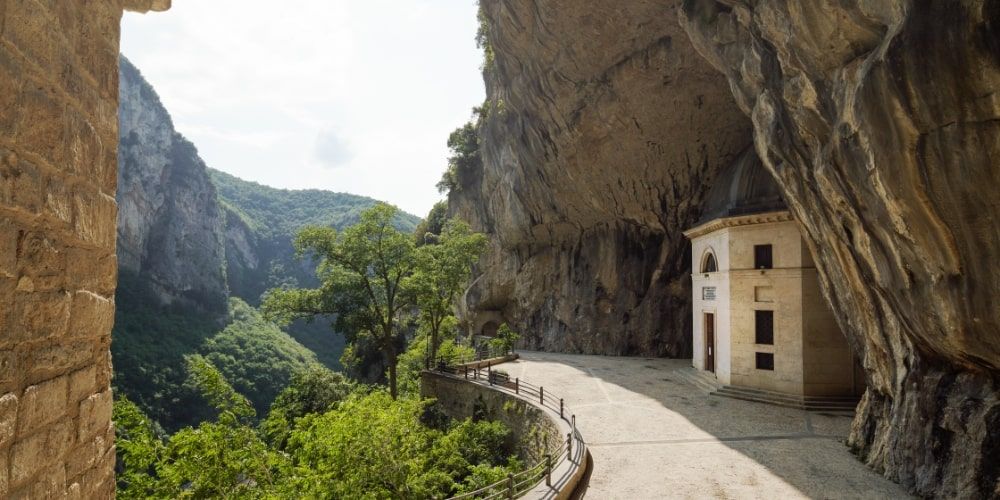
You are in the hidden heart of the Marche region, in the small town of Genga (province of Ancona), nestled within the Regional Natural Park of the Gola della Rossa and Frasassi, an untouched haven of forests, limestone gorges, and crystal-clear streams.
To reach the Temple of Valadier, take the A14 highway, exit at Ancona Nord, follow the SS76 toward Genga, and continue in the direction of the Frasassi Caves, passing them. A little further on, you’ll find a small parking area near the sign for “Presepe Vivente,” the starting point of the trail.
From there, a paved path begins, about 700–800 meters long, mostly uphill, with an elevation gain of nearly 300 meters. The trail is well marked and scenically rewarding, offering glimpses of bare rock, wild nature, and sweeping views over the valleys. Comfortable shoes are highly recommended.
History of the Temple of Valadier
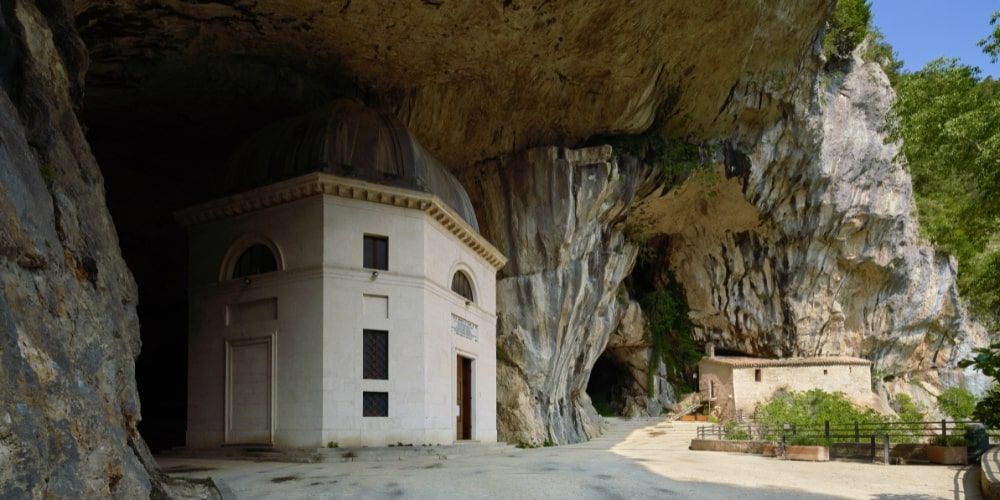
The history of the Temple of Valadier reaches back to the most ancient times. As early as the Upper Paleolithic, between 28,000 and 20,000 years ago, the caves of this area were regarded as sacred places. It was here that archaeologists discovered the famous “Venus of Frasassi,” a small statuette carved from stalactite, interpreted as a symbol of fertility and archaic cults—clear evidence that this mountain had long been shrouded in an aura of sanctity.
Over the centuries, the cave evolved into a place of refuge and prayer. In the Middle Ages, the Hermitage of Santa Maria infra Saxa arose, first mentioned in a document from 1029. This small rock-hewn church was inhabited by Benedictine nuns, who used it as a cloistered sanctuary of silent devotion.
The turning point came in the 19th century. Annibale della Genga, who later became Pope Leo XII, wished to gift his homeland a monumental temple that would merge faith with modern architecture. Thus, between 1827 and 1828, the neoclassical Temple of Valadier was built: an octagonal structure in local travertine, crowned with a lead dome that gleams against the walls of the grotto.
For a long time, the temple was believed to be the exclusive work of architect Giuseppe Valadier. Still, recent studies have revealed that the project was a collaborative effort involving several Marche-based architects, including Tommaso Zappati, Pietro Ghinelli, and Carlo Donati. A collective masterpiece that gave the world one of the most unique churches in Italy—suspended between myth, history, and devotion.
Architecture and features
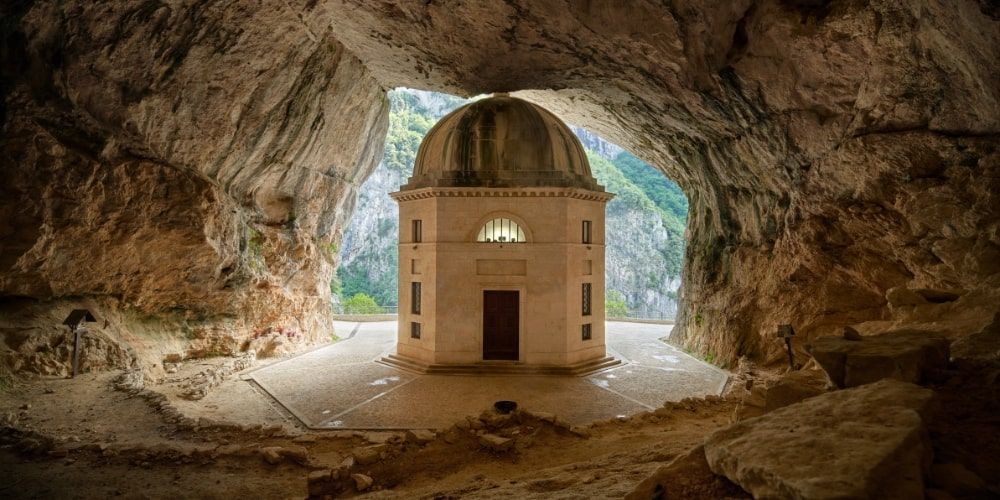
The Temple of Valadier stands out with an extraordinary architectural profile, blending neoclassical elegance with the raw majesty of a cave setting. Its octagonal layout, a symbol of rebirth and geometric perfection, is built entirely from blocks of local white travertine. The dome, divided into eight segments, is clad in sheets of lead.
Inside, at the center of the altar, you’ll find the statue of the Madonna and Child, a copy of the version sculpted by Antonio Canova’s workshop. The original is now kept in the Museum of Sacred Art in Genga, preserved there to protect it from the grotto’s humidity.
The atmosphere is dramatic yet serene and austere. The rocky walls of the cave embrace the structure, while the gleaming white travertine contrasts starkly with the dark gray of the natural stone and the lead-covered dome. You are not merely an observer here—you step into a living canvas, where nature, light, and matter appear to converse with one another.
The experience of visiting the Temple
Get ready for a path that challenges your breath but rewards your eyes: from the small parking area near the “Presepe Vivente” sign, a climb of about 700–800 meters begins. In roughly 15 minutes it leads you to the entrance of the Grotta della Beata Vergine, part of the renowned Frasassi Caves complex. It is here that the Temple of Valadier reveals itself, set into the rocky walls, offering a breathtaking and unforgettable sight.
The best times to visit are late spring and early autumn, when the weather is mild, the air is fresh, and the vegetation is at its lushest. In summer, the sun can be strong along the path, while in winter the light is dimmer and the atmosphere more intimate. In addition, always check the opening hours and special openings by contacting the Frasassi Caves Booking Office.
Don’t forget what to bring: comfortable shoes, a water bottle, a sun hat, layered clothing (as the humidity inside the cave may surprise you), and a camera if you want to capture the magic of the light filtering through the rocks.
What to see nearby
🥇 Visit Italy’s brand partnership
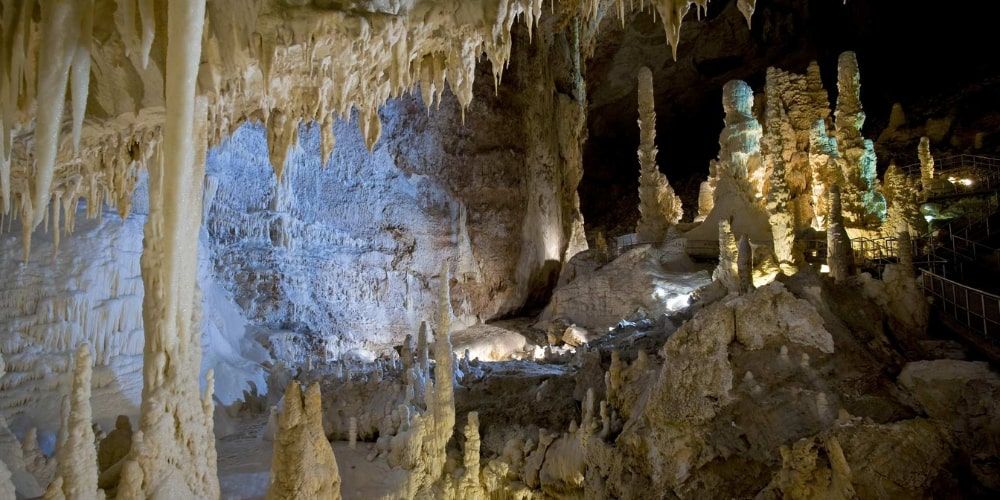
Just beyond the Temple of Valadier, you are already within the majestic Frasassi Caves complex, of which the Grotta della Beata Vergine is a part. This is one of the most spectacular karst systems in Europe, discovered in 1971, spanning over 30 kilometers of tunnels, galleries, and underground chambers. Here lies the Ancona Abyss, a cavern so vast it could contain Milan Cathedral, and along the 1,500-meter tourist route you can marvel at stalactites and stalagmites of incredible shapes, such as the so-called Giants or the Obelisk. The internal temperature remains constant at 57°F (14°C) throughout the year, creating an evocative and enveloping microclimate.
After exploring this natural wonder, continue to the Gola della Rossa and Frasassi Regional Natural Park, a landscape where forests, gorges, and limestone cliffs intertwine in breathtaking scenery. Don’t miss the panoramic trails that run along the gorge, perfect for light hiking and contemplative walks immersed in nature.
The area is also dotted with charming towns: Genga, a medieval gem perched on a hill, with its colorful historic center, the Museum of Art, History and Territory, and its ancient walls; Serra San Quirico, famous for its copertelle, covered walkways and alleys that look like they’ve been lifted straight from a fairytale; and Fabriano, renowned above all for its centuries-old papermaking tradition.
Experience the magic of the Frasassi CavesIs the Temple of Valadier always open?
No, the Temple of Valadier is not always open. Hours vary by season:
• April-May-June-September: from 9:00 a.m. to 6:00 p.m.
• July-August: 9:00 a.m. to 7:00 p.m.
• October-November-December: from 10:00 a.m. to 4:00 p.m.
Access to the Temple of Valadier is managed by the Frasassi Caves. For up-to-date information on opening hours and visiting arrangements, please contact the Frasassi Caves Booking Office at the toll-free number 800 166 250 or at +39 0732 90090.
Is it suitable for families, children, and people with limited mobility?
The Temple of Valadier is easily accessible for families and children, as the path is short and well marked, though uphill. It can also be managed with strollers, while for those with limited mobility the ascent is more challenging due to the slope and the presence of steps.
How long does it take to visit the Temple of Valadier?
The visit takes about an hour, including the time to walk the trail and admire the temple. It can easily be combined with nearby attractions such as the Frasassi Caves.
Is there an entrance fee for the Temple of Valadier?
Yes, admission to the Temple of Valadier requires a ticket. The full price is €6, with a reduced ticket of €4 available for military personnel, disabled visitors, speleologists, CAI members, seniors over 65, university students, journalists, professors with valid ID, and groups without a Frasassi Caves ticket. A €2 reduced ticket is available for children ages 6–14, school groups, and groups with a Frasassi ticket; school groups with a Frasassi ticket pay just €1. Admission is free for children under 6, disabled visitors with companions, Genga residents, licensed tour guides, and teachers accompanying school groups. Additional discounts are available for organized groups.
The ticket price also includes, during certain times of the year and special events, a shuttle service from the nearest parking area to Piazzale Giuseppe Fedeli (where the ticket office is located).
Can the Temple be visited with pets?
Yes, pets are allowed along the trail and in the outdoor area of the grotto. However, they must be kept on a leash to ensure safety and respect for the site.
About the author
Written on 23/09/2025


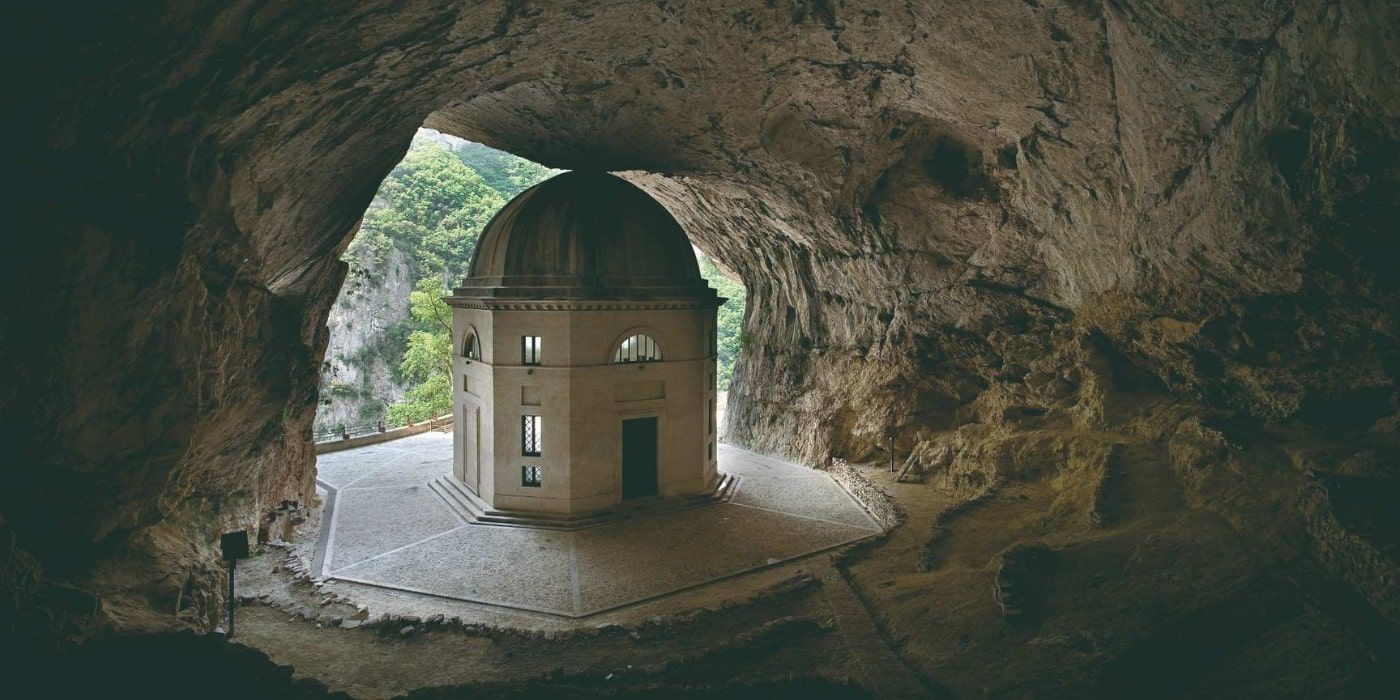


Rossella Friggione
Discover one of Italy's most unique churches: the Temple of Valadier, a neoclassical temple hidden in a cave near the Frasassi Caves.